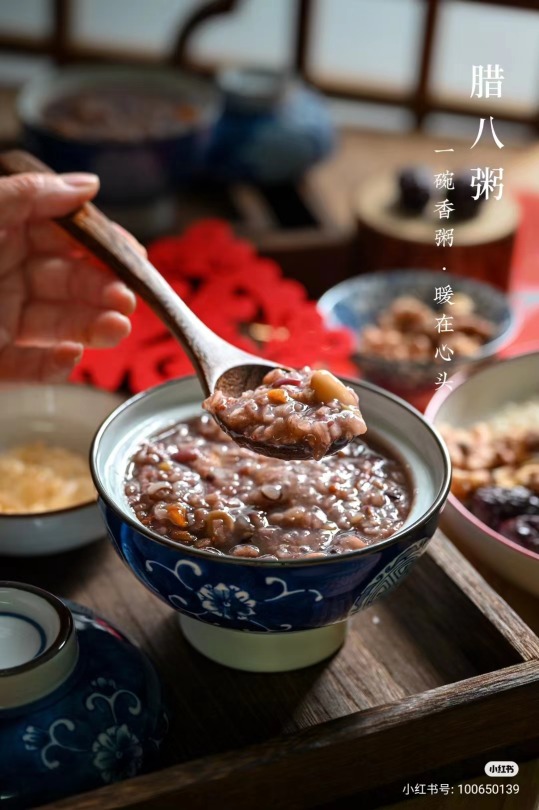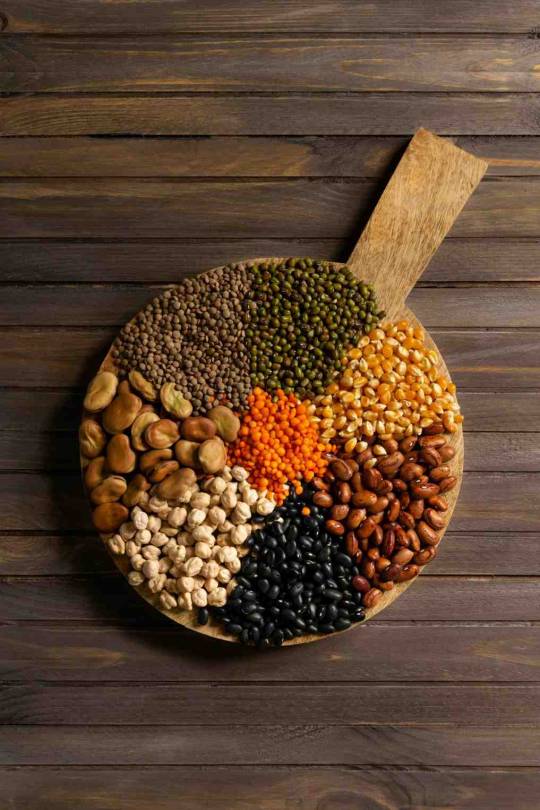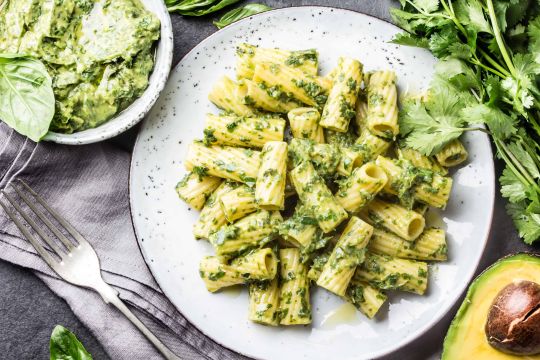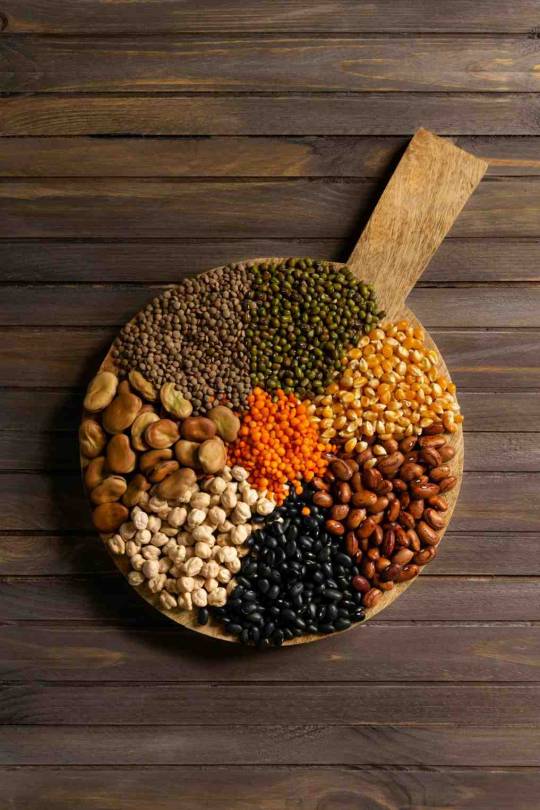#Mung bean modeling
Explore tagged Tumblr posts
Link
1 note
·
View note
Text
Understanding growth patterns of mung beans (Vigna radiata) through polynomial interpolation: Implications for cultivation practices
Abstract This study aims to explore the germination and growth patterns of mung bean seeds (Vigna radiata) through a polynomial interpolation fitting approach in a controlled environment. Mung beans are also popular in Asian diets, are used in many dishes, and have lots of nutritional value. The study is meant to describe the germination and growth pattern of mung beans over six successive days,…
0 notes
Text
[Traditional Chinese Festival] Customs of 臘八節(Laba Festival) in China.Eng Sub
Today(January 18, 2024) is the traditional Chinese festival,臘八節 Laba Festival.Let’s learn about some interesting traditions and customs about this festival.
【About 臘八節(Laba Festival)】
Laba Festival (Chinese:臘八節) is a traditional Chinese holiday celebrated on the eighth day of the month of La (or Layue 臘月), the twelfth month of the Chinese calendar. It is the beginning of the Chinese New Year period. It is customary on this day to eat Laba congee.
Laba Festival was not on a fixed day until the Southern and Northern dynasties, when it was influenced by Buddhism and was fixed on the eighth day of twelfth month, which was also the enlightenment day of the Buddha. Therefore, many customs of the Laba Festival are related to Buddhism.
The Laba Festival's name represents its date on the Chinese calendar. La is the name of the twelfth and final month, and ba means "eight/八". In ancient China, the "eight/八" referred to making sacrifices to eight gods at the end of the year.
In its original form, the festival was celebrated by making sacrifices to gods and ancestors to wish for good fortune, health, safety, and a good harvest in the new year. The word la originally referred to these sacrifices.
After Buddhism spread to China during the first century CE, the festival was used as commemoration of Gautama Buddha's enlightenment.It was given a fixed date (the eighth day of the twelfth month) during the Northern and Southern dynasties.
【Customs of 臘八節/Laba Festival?】
Laba congee/臘八粥

Traditionally, the consumption of Laba congee is an important element of the festival. There are multiple legendary accounts of the dish's origins. One story says that it originated in the Song dynasty with Buddhist monasteries giving congee to people in honor of the story that Sakyamuni (Gautama Buddha) reached enlightenment on the eighth day of the twelfth month after eating congee.
Laba congee or Laba porridge (臘八粥; Làbāzhōu) is very popular in many places in China. Different kinds of rice, beans, nuts and dried fruits are the main ingredients. People believe that it's good for health in the winter.
It is also known as "eight-treasure congee" (八宝粥; Bā bǎo zhōu)and is usually made with eight or more ingredients, representing good luck. Eight is a lucky number in China, and the ba in Laba also means eight.
There are many variations of Laba congee in different regions of China. Ingredients can include mixed grains, such as rice, millet, and barley; beans and nuts such as mung beans, azuki beans, lotus seeds, peanuts, walnuts, and chestnuts; dried fruit such as red dates, longan, raisins, and goji berries; and other ingredients such as vegetables and meat.
2.Laba garlic/臘八蒜

Another Laba food is Laba garlic, which is particularly popular in northern China.Garlic in Chinese (蒜; suàn) has the same pronunciation as calculate (算; suàn), and it is said that on the Laba Festival businesses should balance their books and calculate their revenues and expenditures for the year.Laba garlic is made by soaking garlic in vinegar. Laba garlic is soaked in vinegar from the Laba Festival until Chinese New Year. The garlic and vinegar are then used alongside Chinese dumplings (jiaozi) around Chinese New Year.
————————
🧚🏻Model/Makeup:@曾嚼子&@兔狲猫眠眠
📸 Photo:@逸群闲余
🔗 Xiaohongshu:http://xhslink.com/zlF8Hz
————————
#chinese hanfu#hanfu#Traditional Chinese Festival#臘八節 Laba Festival#chinese culture#chinese customs#chinese history#hanfu accessories#chinese food#china#chinese new year#song dynasty
205 notes
·
View notes
Text
On my eleventh birthday, Prime Minister Lu gave me the most incredible miniature city. It was a replica of Xianyang's main square, sculpted from clay and so faithfully painted that every red door and thatched roof was rendered in breath-taking detail. It came with its own enormous, custom-built table, spanning one zhang and five chi in total. The model was clearly meant to be a display item, but I loathed to show it to anyone, not even the other princes. I kept it in my room, and none of the other servants were allowed to dust it, except for Zhao Gao.
The best part was the buildings were not glued down. They could be moved around like the pieces on a chessboard. I would spend entire afternoons gently picking each one up and weighing them in my hands. I imagined this was similar to what Pangu felt when he opened the heavens and split the earth. I had always wondered why a giant wouldn't go rampaging across the countryside, levelling mountains and stomping towns into splinters just for the thrill of it. No one would have been able to stop him, after all. Now that I had a taste of that power, I felt intensely protective. No harm was allowed to come to Little Xianyang. I accidentally dropped the townhall once and burst into tears over it. Zhao Gao eventually fixed it with some flour paste, and you could barely see the cracks, but it still left me heartbroken.
This city was perfect. So absolutely perfect. Except for one small thing: there were no people! What good was an empty, uninhabited shell? I didn't want to be the king of silent walls and deserted streets. I wanted my city to be alive and busy, filled with bustling crowds, rumbling wheels, braying animals and the smell of smoke and food.
That became my new project: populating table-top square. After deliberating the matter with Zhao Gao, we raided the kitchens and returned with several bowls of beans. I had them all arranged according to shape, colour and size. Red kidney beans for the soldiers, black dragon-eyes for the gentry, blue mung beans for the scholars, and white soybeans for the common folk. It was so satisfying to spoon them into the streets and watch them wobble around, almost as if they had a mind of their own. I would have preferred to have more accurate representations of people with unique faces and clothes, but not even Nuwa could create those details on such a small scale. In any case, the beans made up for it by being so numerous and colourful. If I squinted my eyes, I could almost believe I was looking at a crowd from far away.
The city became a small window into the outside world. An escape I desperately craved. I had been in Qin for over a year, but I was rarely allowed to leave the palace. For once, the Prime Minister and King were in perfect agreement over something. The Crown Prince was not supposed to mingle with the common masses. In an ironic turn of events, I had less freedom in Qin than I did in Zhao, where I was surrounded by enemies who wanted me dead. I could count on one hand the number of times I was allowed to have an outing. How I treasured those bright little moments, preserved so clearly in my mind’s eye like an insect trapped in amber. It's strange to think that since then I’ve become the most well-travel man in the Empire. Perhaps the whole world. I’ve summited the highest peaks and visited each of the four seas. Yet the sight of all those wonders could not match the same thrill I felt as a boy, riding for a whole sichen in a stuffy carriage to travel across the city to visit Grand-Uncle Soandso and Second-Cousin Whatshisname.
The trips gave me so much inspiration. If I saw a fault somewhere, I would try to come up with ways to improve it. Once, when we were crossing the East Marketplace, it suddenly dawned on me that the roads were always heavily congested. I drew up the curtains and poked my head outside, much to the dismay of Zhao Gao.
"Your Highness!"
"Oh, hush, I just want to see what's going on."
"Please lower the curtain, Highness, it isn't proper."
I rolled my eyes. He could be such an old biddy sometimes, especially with that high-pitched, girly voice. Half the fun was teasing him. "I am the crown prince. Who’s to tell me what is or isn't proper?"
Zhao Gao glanced anxiously at my mother’s carriage behind us. "My Prince, I beg you. Even if you don't get into trouble, l will!"
Groaning in annoyance, I dropped the curtain and peeked out the side instead. "There! Happy now?"
Zhao Gao was not happy but wisely decided to cut his losses. He was only a eunuch, no matter how well-liked, and my patience with him only went so far.
I squinted out across the sea of heads and horses. It was apparent that the streets were badly designed. There were not enough walkways, and everyone was forced into the same exit and entry points. I spent the remainder of the journey pondering the problem, my mind churning as madly as the clogs in my mother’s loom when it was producing a great length of silk. The minute my carriage stopped at the palace, I was off like a loose arrow with Zhao Gao's long-suffering voice echoing in my ears, "My Prince, please don't run!"
I spent the rest of the evening bustling around my model city, jotting down calculations on my handkerchief. First I measured the streets with my thumb and forefinger. Next I put all the buildings together and measured their total area. To my delight, I saw that the numbers worked out. I could fit a new street, I just needed to be clever about it. That was one of the caveats I’d set for myself. I couldn't get rid of any of the houses-- where would my citizens live, otherwise? Nor could I encroach on any of the neighbouring areas, or shrink the marketplace. With those goals in mind, I got to work widening the throughfare and reorganized the buildings. Zhao Gao knelt beside me, silently grinding ink and occasionally interjecting helpfully; “you forgot to carry the one, My Prince.”
By the time I finished the sky was dark and the lamps had been lit, though I had not noticed the servants coming in. Grinning from ear to ear, I stepped away from the table in order to admire my work in its entirety. What had once been a column of numbers had been transformed into reality. I cleared my throat and announced in the grand voice I’d been practicing, "I decree this new marketplace open!" With that, the little bean people rolled happily into the new streets, cheering for their clever king.
Notes: there's something so deliciously ironic about making ying zheng an idealistic child who dreams of improving his citizens lives with grand infrastructure projects vs what he actually ends up doing.
"What good was an empty, uninhabited shell? I didn't want to be the king of silent walls and deserted streets."
aw don't cry buddy. maybe one day the archeologists will crack Mt Li open and you won't be alone anymore.
Green and blue were referred to by the same word 'qing' 青. The “blue” beans he is talking about are actually green mung beans.
Pangu—a primordial giant who created the world.
Nuwa—a goddess who created the first humans from clay.
Dragon eyes – transliteration of longan, the fruit was first recorded in the Han dynasty, but could plausibly have existed during the Qin.
#got writers block from chu han so i wrote this. bomb apple tea.#qin shi huang#the grandmaster of public infrastructure#my writing#things i discovered about myself; writing from the POV of a mad tyrant is easy. writing from the POV of someone who loves maths is hard.
48 notes
·
View notes
Text

The very handsome Brother... and role model..

"Hey, what are we doing?" Mr Mung joins his Uncle.

"I can do Right Paw too! I am most clever Bean!"
Silken Windhounds, Uncle the Brother and Mr Mung Bean
#the Brother#Mr Mung#clever#silken windhound#sighthound#photozoi#10-1-23#original photos#learning#new puppy#right paw
31 notes
·
View notes
Text
Excerpt from this story from National Geographic:
These days, the village of Karauzyak in western Uzbekistan is a dusty place. Surrounded by an arid landscape of dry scrub grasses and salt-crusted soils, it’s hard to believe the village was once along the banks of a swollen river, 30 miles from the shore of the world’s fourth-largest lake. Over the last 50 years, that lake, the Aral Sea, has dried up almost entirely, in what is often called the “world’s worst environmental disaster.” Now, it’s hard to farm much of anything in Karauzyak—except for atriplex, or saltbush.
In a 3.5-hectare plot of land near the village, a team of Japanese researchers is growing this salt-loving plant, known scientifically as a halophyte, to see if it can be a viable crop for farmers in the region and even nurture a small dairy industry. They’ve fed it to cows at a nearby farm and found that it helps lock scarce moisture into the thirsty soil, and it can be grown without extensive fertilizer use.
As she holds up a dusty green twig of atriplex, Kristina Toderich, a halophyte expert from Tottori University in Japan, explains why the salt-loving plant excites scientists like her: “This doesn’t need water. It doesn’t need anything.”
Toderich is one of the lead researchers on a project using the former seabed and nearby river delta as a living laboratory. It’s part of a larger Japanese foreign aid and scientific collaboration initiative called SATREPS. Working with Uzbekistan’s hydrometeorological service, UZGIP, the researchers are collecting real-time climate data and satellite imagery to better understand the conditions in the Aral Sea area: how much water is left, how fast it’s disappearing, and what kind of crops are being farmed there.
Based on the results, they’re drafting a model for sustainable agriculture in the region, recommending that farmers adopt new irrigation methods and plant crops that are more salt- and drought-tolerant, says Kenji Tanaka, a hydrologist who studies the effects of climate change on water resources and the head of the SATREPS project.
The United Nations Convention to Combat Desertification has warned that an area of land the size of Central Asia has become degraded from drought, salinization, and overuse since 2015. By learning what can grow in the Aral Sea, SATREPS could provide solutions for other parts of the world that are facing similar problems, from the Lake Chad basin in Western Africa to the Great Salt Lake in Utah.
It's unclear whether the Uzbeki government will adopt the recommendations made by the SATREPS team. But so far, the country seems open to change; President Shavkat Mirziyoyev, who promised to loosen the rigid Soviet-era policies of his predecessor, Islam Karimov, ended the requirement that all Uzbek citizens pick cotton if called upon, and has spoken at the United Nations about the effects of desertification and land degradation on his country.
Climate change makes these adaptations even more urgent. Average temperatures in the Aral basin have increased by around 3.6 degrees Fahrenheit since 1968. And the shrinking of the Aral Sea itself has affected the climate; as the water disappeared, the air became drier and lost the cooling effect of the nearby lake, creating a feedback loop that resulted in hotter and drier weather. Sandstorms now spread dust and toxic heavy metals to nearby villages, while retreating water has caused a build-up of salts in the soil.
Tanaka’s project has several components. Aside from atriplex, SATREPS researchers are planting crops like sorghum, mung bean, and amaranth in test plots to learn which can best survive in dry, saline soil. So far, they’ve developed promising varieties of winter wheat and barley.
6 notes
·
View notes
Text
India's Leading Beans Brands & Dealers – Explore & Buy Today!
India, being one of the largest agricultural economies in the world, plays a significant role in the production and supply of various pulses and legumes. Among them, beans hold a special place due to their rich nutritional profile and daily use in Indian households. From rajma to black beans, mung to lobia, the demand for quality beans is ever-increasing. That’s why choosing a trusted beans brand in India is essential for both consumers and businesses.

In this detailed guide, we’ll explore why beans are a staple, what makes a brand reliable, how to find the best beans suppliers in India, and why so many buyers trust Valency Agro as their preferred beans company in India.
Why Beans Are Essential in Indian Diets
Beans are a powerhouse of protein, fiber, vitamins, and minerals. In a predominantly vegetarian country like India, beans act as a primary source of protein and are used in hundreds of regional recipes. Whether it’s Rajma-Chawal in the North or Sprouted Moong Salad in the West, beans are indispensable.
Their versatility and affordability make them a top choice not just in home kitchens but also in restaurants, hostels, caterers, and FMCG brands. This rising demand is being met by companies like Valency Agro, which specialize in sourcing and supplying high-quality beans across the country and abroad.
What Defines a Trusted Beans Brand in India?
A reliable beans brand in India is not just about packaging or marketing—it’s about delivering consistent quality, nutritional value, and supply-chain reliability. Some of the key qualities include:
Clean and Grade-A Quality Beans
Hygienic Packaging and Processing
Adherence to Food Safety Standards
Nationwide Dealer and Distributor Support
Affordable Bulk and Retail Pricing
Brands that ensure these essentials often emerge as leaders in the market. Valency Agro, for instance, meets all these benchmarks while maintaining transparency and commitment to quality.
Meet Valency Agro – India’s Trusted Name in Beans
Among various beans suppliers in India, Valency Agro has earned a solid reputation for its reliability, consistency, and ethical sourcing. Whether it’s raw Rajma from the North or organic Moong from the South, Valency Agro brings premium-quality beans directly from farms to kitchens.
The company focuses on every step of the process—from working with local farmers to ensuring modern warehousing, processing, and packaging. Their strong focus on quality has helped them emerge as a preferred beans company in India, serving both domestic and international markets.
Wide Range of Beans Available at Valency Agro
As a full-scale beans brand in India, Valency Agro offers a wide variety of beans suitable for different culinary and commercial needs:
Kidney Beans (Rajma)
Black Beans
Moong Beans (Green Gram)
Black-Eyed Peas (Lobia)
Soybeans
Chickpeas (Kabuli & Desi)
Each variety is carefully tested for purity, moisture levels, and grain size, ensuring top-grade quality. This makes Valency Agro the go-to choice for chefs, nutritionists, and businesses looking for dependable bean sources.
Distribution Network – Reaching Every Corner of India
What makes a beans brand in India truly successful is its ability to deliver consistently across geographies. Thanks to its robust supply chain, Valency Agro works with several beans dealers in India, ensuring seamless delivery and stock availability.
From local kirana stores to wholesalers and institutional buyers, the company supports all kinds of distribution models. This wide reach, combined with flexible packaging sizes (1kg, 5kg, 25kg, and bulk), makes Valency Agro one of the most versatile beans suppliers in India.
Valency Agro’s Commitment to Quality and Safety
Maintaining international food safety standards is essential, especially when catering to both domestic and export markets. As a trusted beans company in India, Valency Agro follows:
FSSAI Guidelines
ISO Certifications
HACCP-Compliant Processes
Sustainable Farming Partnerships
These ensure that every pack of beans not only meets quality expectations but also supports ethical and eco-friendly practices.
Beans Dealers in India – Powered by Valency Agro
India’s bean market is largely driven by an active network of dealers and stockists. Valency Agro partners with several beans dealers in India who distribute their products in metros, tier-2 cities, and rural areas alike.
Dealers benefit from:
Timely dispatches
Transparent pricing
Product training and support
Attractive margins
Whether you’re starting a new food supply business or expanding your retail footprint, becoming a dealer of Valency Agro is a smart choice.
Why Businesses Choose Valency Agro Over Other Brands
For restaurants, caterers, exporters, and FMCG companies, sourcing beans is not just about cost—it’s about reliability. Here's why Valency Agro is often the preferred beans brand in India:
Consistent Quality
Bulk Availability
Fast Delivery
Clear Traceability
Responsive Customer Support
In a market where delays or quality issues can lead to financial losses, Valency Agro provides peace of mind through a professional, process-driven approach.
A Look into the Future – India’s Beans Industry
As demand grows for plant-based proteins and healthy food alternatives, the Indian beans market is expected to double in the next 5 years. Health-conscious consumers are looking for cleaner, safer food options, and companies like Valency Agro are ready to meet this demand.
Their focus on:
Digital Ordering Systems
Sustainable Packaging
Farmer Empowerment Programs
Organic Product Lines
makes Valency Agro not just a beans supplier in India, but a future-ready food company.
How to Order Beans from Valency Agro
Ordering from Valency Agro is simple and hassle-free. Whether you're a wholesaler, retailer, exporter, or institutional buyer, you can:
Visit their official website
Fill in the inquiry form for bulk orders
Get samples on request
Choose custom packaging options
Track delivery and support through dedicated account managers
They also offer consultation to help you decide the best beans variety for your specific use case—be it for retail, processing, or culinary needs.
Conclusion
Finding the right beans brand in India is crucial if you care about quality, hygiene, and long-term value. While the market has many players, only a few companies like Valency Agro combine all the necessary factors—quality control, ethical sourcing, supply reliability, and customer support.
Whether you're searching for dependable beans suppliers in India or want to connect with established beans dealers in India, putting your trust in Valency Agro ensures satisfaction and success.For retailers, bulk buyers, and health-conscious consumers alike, Valency Agro stands tall as a leading beans company in India—one that doesn’t just sell beans, but builds trust.
0 notes
Text
Vegan Protein Bars Market: Global Segments, Top Key Players, Size And Recent Trends By Forecast To 2035
The Vegan Protein Bars Market is poised for robust expansion, projected to grow at a compound annual growth rate (CAGR) of 17.8% over the forecast period. The market is expected to rise from USD 1,054.7 million in 2025 to a staggering USD 5,427.4 million by 2035. This upward trajectory is driven by the global surge in demand for functional, clean-label snacks that align with plant-based nutrition and active lifestyles.
The increasing preference for plant-based diets is significantly contributing to the growth of this market. Consumers are turning to vegan protein bars made from pea, rice, hemp, quinoa, and pumpkin seed proteins due to their perceived health benefits. These include better digestion, weight management, and reduced risk of chronic illness. As more individuals seek convenient, on-the-go sources of vegan nutrition, the demand for these bars continues to accelerate, especially among fitness enthusiasts, health-conscious millennials, and ethical consumers.
Stay Informed – Request a Sample Copy for Exclusive Insights
Key Takeaways:
The market is projected to grow at 17.8% CAGR, reaching USD 5.4 billion by 2035.
Major protein sources include pea, rice, hemp, quinoa, mung bean, and pumpkin seed.
Growth is spurred by plant-based trends, fitness culture, clean labeling, and sustainability demands.
North America, Europe, and Asia-Pacific are key growth regions.
Innovation in flavor, texture, packaging, and certifications is shaping competition.
Market Dynamics:
Drivers:
Rising consumer interest in plant-based and clean-label nutrition.
Increasing gym memberships, sports culture, and wellness awareness.
Supportive regulations around non-GMO, allergen-free, and eco-friendly food products.
Influence of vegan influencers, athletes, and celebrities endorsing plant-forward snacking.
Restraints:
Higher product cost compared to conventional protein bars.
Taste and texture limitations in early-stage formulations.
Limited consumer awareness in some developing regions.
Opportunities:
Expansion in e-commerce and subscription-based protein snack models.
Technological advancements in protein extraction and food tech innovation.
Regional customization and local ingredient sourcing.
Recent Developments in the Market:
Clif Bar & Company recently launched a new range of high-protein vegan bars in North America aimed at athletes.
Nestlé-owned Garden of Life has expanded its vegan protein snack line into the UK and Germany with new clean-label SKUs.
South Korean startups are using AI-based nutritional modeling to customize plant-based snack bars for individuals.
Japan’s Asahi Group has introduced matcha and sesame-infused protein bars targeting local taste preferences.
Unilever has announced plans to acquire a plant-based snack brand to increase its presence in the vegan functional foods market.
Key Benefits for Stakeholders:
Manufacturers gain access to a rapidly expanding and innovation-friendly market.
Retailers benefit from premium pricing and increased shelf space.
Investors can tap into a high-growth sector driven by health and sustainability trends.
Consumers receive convenient, ethical, and health-aligned nutrition options.
Policy makers find alignment with food sustainability and clean-eating initiatives.
Gain Full Market Perspective – Get the Full Report Today
Competitive Analysis:
The market is moderately fragmented, with several multinational and emerging players investing in innovation, sustainability, and brand positioning.
Key Players Include:
Clif Bar & Company
RXBAR (Kellogg’s)
Vega (Danone)
Garden of Life (Nestlé)
No Cow
BHU Foods
ProBar LLC
Orgain Inc.
GoMacro
Amrita Health Foods
These players compete on product differentiation through natural ingredients, protein variety, sugar reduction, allergen-free formulations, and eco-friendly packaging. Regional startups and niche players are also capturing market share by responding to local taste preferences and lifestyle trends.
Country-wise Market Analysis:
United States (CAGR: 18.2%) With a booming fitness culture and the highest global demand, the U.S. leads the vegan protein bar market. Brands are launching high-protein, low-sugar bars aimed at gym-goers and millennials. California and Texas are hotspots for innovation using pea, hemp, and brown rice protein. E-commerce and clean-label trends further drive growth.
United Kingdom (CAGR: 17.6%) The UK market benefits from strong sustainability values and health-oriented snacking. Consumers favor bars with oat, quinoa, and pumpkin seed protein. Retailers like Waitrose and Ocado promote private-label offerings, while vegan influencers and sports personalities drive brand engagement.
European Union (CAGR: 17.9%) EU countries are adopting vegan bars in alignment with Green Deal initiatives and food labeling regulations. Germany, Sweden, and the Netherlands lead in producing soy-free, allergen-friendly bars. The EU push for recyclable packaging and organic labeling supports further expansion.
Japan (CAGR: 17.3%) Japan’s aging population and fitness-focused youth are fueling demand for compact, nutritious vegan bars. Native ingredients like adzuki beans and matcha give local brands a cultural edge. Government-backed wellness programs and premium packaging contribute to a thriving niche market.
South Korea (CAGR: 18.0%) Driven by wellness trends and K-pop celebrity endorsements, South Korea is seeing rapid adoption of mung bean, soy, and pumpkin seed bars. The popularity of personalized nutrition, combined with government support for plant-based food innovation, positions South Korea as a fast-emerging market.
Vegan Protein Bars Market Segmentation
By Nature:
Organic
Conventional
By Flavor:
Chocolate-Vanilla
Chocolate-Caramel
Peanut Butter
Cherry Cashew
Fruit & Nut
Hazelnuts
Others
By Ingredient Type:
Soy
Pea
Nuts
Hemp
Others
By Distribution Channel:
Convenience Stores
Hypermarkets/Supermarkets
Traditional Grocery Stores
Drug Stores & Pharmacies
Health & Wellness Stores
Online Retailing
By Region:
North America
Latin America
Western Europe
Eastern Europe
East Asia
South Asia Pacific
Middle East and Africa
0 notes
Text
Plant-Powered Future: How Alternative Proteins Are Reshaping Agriculture

You’ve probably noticed a shift in what people are eating, talking about, and investing in—plant-based and lab-grown proteins are gaining serious ground. What used to be a niche corner of the market is now reshaping how crops are grown, where investments go, and what your next farming opportunity might look like. As demand rises for protein that’s not reliant on traditional livestock, agriculture is pivoting toward new inputs, systems, and partnerships. This article walks you through how alternative proteins are creating real-world change in agriculture, and how you can adapt, benefit, and lead in this fast-moving sector.
Alternative Proteins: What You’re Working With Now
Alternative protein refers to anything that delivers protein without traditional animal farming. That includes plant-based products made from soy, peas, chickpeas, mung beans, and lentils; fermentation-based proteins created using microbial processes; and cultivated or cell-based meat, which grows muscle cells in a lab environment. Each of these categories has moved from experimental to commercial, with major brands and start-ups building entire business models around them.
You don’t need to overhaul your farm to get involved. If you're already growing pulses or soy, you might already be part of the supply chain. If not, expanding into high-protein crops or aligning with new food tech buyers can open a door. Consumer demand is pushing food companies to innovate, and they’re looking for reliable growers and suppliers to keep pace.
How This Changes What You Grow
Crop patterns are already shifting. Soy remains a staple, but the interest in peas, fava beans, lentils, and chickpeas is pushing acreage increases globally. These crops have multiple upsides: they grow well in diverse conditions, fix nitrogen into the soil, and can be rotated with cereals to improve long-term yield.
You’re likely to see more vertical integration—companies investing directly in growers or offering long-term contracts for alternative protein inputs. That gives you more stability and predictability. If you're currently focused on commodity crops, this shift can open the door to value-added opportunities with premium buyers.
Even wheat is seeing action. Some food-tech startups are using wheat gluten and wheat protein isolates as binding agents in plant-based meat formulations. If you’ve written off protein markets because you’re not growing soy, think again.
What Happens to Animal Agriculture?
This shift doesn’t mean livestock disappears. What’s happening is a rebalancing. Consumers want choices, and those choices now include plant-based burgers, cultured seafood, and fermentation-derived egg proteins. That puts some pressure on feed crops and traditional animal protein markets. But there’s room to pivot.
If you're a livestock producer, you might explore feedstock partnerships with plant protein processors or use byproducts from fermentation as feed inputs. Some livestock operations are also branching into co-production—growing protein crops alongside animal systems to meet a broader range of buyer needs.
You’re also likely to see pressure from sustainability regulations. Livestock systems with high emissions or poor waste handling will have a harder time competing in markets where carbon and environmental performance are tracked. But operations that integrate sustainable feed, pasture management, or co-located biogas production can stand out.
The Supply Chain Is Getting Smarter
Alternative protein producers are laser-focused on traceability. Whether you're selling peas to a processing plant or contracting soybeans for protein isolate, you're going to need clean data—input sources, growing practices, transport details, and moisture levels at delivery. Blockchain and traceability tech are becoming standard, especially for companies targeting export markets.
This also means better access to premiums if you’re meeting certain standards. Organic, non-GMO, or regenerative practices are highly sought after by companies trying to tell a clean supply story to their consumers. You can use that demand to your advantage by aligning with buyers who reward verified production methods.
Processors want to know their inputs are consistent. Clean, uniform crops with reliable protein content are worth more than commodity bins mixed from multiple farms. Working directly with protein buyers gives you leverage—and more room to negotiate based on quality, not just quantity.
Where Fermentation and Cultivated Meat Fit In
You might think fermentation or cultivated meat is out of reach for a traditional farm—but that's changing. Fermentation facilities need feedstock: sugars, starches, or plant-based inputs to grow their cultures. Many rely on glucose derived from corn or wheat. That puts you in the game if you’re growing either and can meet purity specs.
Some operations are also developing co-located fermentation plants near grain-growing areas to cut logistics costs. If you’re looking for long-term buyers and can supply consistent quality, it’s worth exploring partnerships or regional supply calls.
Cultivated meat companies are still scaling, but they too will need plant-based inputs for scaffolds, nutrients, and culture media. Some are already working with ag-tech companies to develop more affordable feed inputs grown through conventional methods. There’s potential here, and it's growing faster than most forecasts expected even a year ago.
Global Trends Driving Market Growth
Consumer habits are only part of the story. Governments are getting behind alternative proteins as a food security tool. Singapore, Israel, and the Netherlands are funding cultivated meat pilot plants. Canada and Denmark are investing in pea protein extraction facilities. In the U.S., the USDA and DOE are both funding research into plant-based food systems and fermentation tech.
If you’re watching crop subsidies or rural development incentives, look out for programs tied to high-protein legumes or low-carbon food innovation. These are often targeted at newer markets but can benefit traditional farms that pivot early.
The biggest retailers in the world—Walmart, Tesco, Kroger—are giving shelf space to plant-based protein brands and asking suppliers to help meet their ESG targets. That signals long-term investment, not just a marketing fad.
How are alternative proteins changing agriculture?
Driving demand for high-protein crops like peas and lentils
Shifting land use away from feed crops
Increasing traceability and quality standards
Creating new markets for fermentation feedstock
Encouraging farmers to diversify and access premium buyers
In Conclusion
The future of protein is being rewritten, and you're in a position to play a leading role. Whether you're growing pulses, managing feed grain operations, or looking to connect with emerging food companies, the door is wide open. With real buyer demand, growing government support, and constant product innovation, alternative proteins aren't just disrupting agriculture—they’re redefining its opportunities. The smartest move you can make is to look at where your current operation intersects with this trend—and make sure you're not watching from the sidelines when you could be supplying the next big product on grocery shelves.
Stay updated on the latest agri-food innovations and market shifts—subscribe to Dax Cooke on Substack.
0 notes
Text
Vegan Pasta Market: Global Trends and Forecast to 2030
Introduction
As global consumer preferences continue to shift toward healthier and more sustainable food choices, the vegan pasta market has emerged as a thriving segment within the plant-based food industry. Driven by a growing demand for meat-free, dairy-free, and egg-free alternatives, vegan pasta is gaining traction among health-conscious consumers, environmentally aware individuals, and those with dietary restrictions.

With innovative product offerings and an expanding retail presence, the global vegan pasta market is expected to experience significant growth through 2030. This article explores key trends, market drivers, challenges, and forecasts shaping the future of vegan pasta worldwide.
Market Overview
The global vegan pasta market was valued at approximately USD 1.1 billion in 2022 and is projected to reach USD 2.3 billion by 2030, growing at a CAGR of 9.6% during the forecast period. This growth is fueled by increasing vegan and flexitarian populations, rising awareness of plant-based nutrition, and expanding product innovation.
Key Market Drivers
1. Rising Health Consciousness
Consumers are increasingly opting for vegan pasta due to its perceived health benefits, including:
Lower cholesterol and saturated fat
Richness in fiber and essential nutrients
Gluten-free and allergen-friendly options
2. Sustainability and Ethical Eating
Environmental concerns and animal welfare issues are prompting consumers to shift toward plant-based foods. Vegan pasta aligns with sustainable agriculture practices and a lower carbon footprint.
3. Product Innovation
Manufacturers are developing a wide array of vegan pasta made from:
Lentils, chickpeas, and black beans
Brown rice, quinoa, and amaranth
Zucchini and other vegetable-based alternatives
These offerings cater to diverse tastes and dietary preferences.
4. Retail Expansion and E-commerce
Vegan pasta products are now widely available in:
Supermarkets and health food stores
Online grocery platforms
Direct-to-consumer subscription models
Improved availability and convenience are broadening consumer access.
Emerging Trends
A. Clean Label and Organic Ingredients
Consumers are increasingly seeking pasta made from non-GMO, organic, and minimally processed ingredients. Brands that emphasize transparency and sustainability are gaining a competitive edge.
B. High-Protein and Fortified Pasta
To meet nutritional needs, companies are offering vegan pasta fortified with:
Plant-based protein
Omega-3 fatty acids
Added vitamins and minerals
This makes vegan pasta more appealing to athletes, fitness enthusiasts, and families.
C. Flavor and Texture Improvements
Advancements in food science are enabling manufacturers to create vegan pasta with:
Improved mouthfeel and elasticity
More authentic taste profiles
Better cooking performance and shelf stability
Regional Insights
🌍 North America
Leading the global market in terms of innovation and product launches
Strong growth driven by veganism and plant-based diet trends
Key players include Tolerant Foods, Explore Cuisine, and Banza
🌍 Europe
High demand in the UK, Germany, Italy, and France
EU initiatives supporting plant-based food development
Traditional pasta consumers increasingly embracing vegan alternatives
🌍 Asia-Pacific
Fastest-growing region, especially in urban centers
Rising health awareness and lactose intolerance cases driving demand
Local manufacturers entering the market with rice and mung bean pasta
Competitive Landscape
The vegan pasta market is highly competitive and fragmented, with both global food giants and emerging startups contributing to growth. Key companies include:
Barilla Group – Expanding its plant-based product line
Nestlé – Investing in vegan-friendly convenience foods
Ancient Harvest – Specializing in quinoa-based pasta
Pastabilities, Explore Cuisine, and Banza – Innovators in niche vegan formats
Strategic partnerships, mergers, and sustainable packaging are also becoming key differentiators.
Challenges and Barriers
While the outlook remains optimistic, the market faces several challenges:
Higher production costs compared to traditional pasta
Limited consumer awareness in developing regions
Taste and texture preferences still favor traditional wheat pasta among some consumers
Overcoming these hurdles will require education, pricing strategies, and continuous R&D.
Market Forecast to 2030
YearMarket Size (USD Billion)20221.120251.620302.3
The market is expected to maintain strong, steady growth, supported by innovation, sustainability trends, and global demand for ethical and health-forward products.
Conclusion
The vegan pasta market is evolving from a niche segment into a mainstream category within the global food industry. With rising consumer demand for plant-based, nutritious, and sustainable alternatives, brands that innovate and align with clean-label values are poised for long-term success.
As the world moves toward a more conscious way of eating, vegan pasta represents more than a dietary choice—it embodies the future of food.
0 notes
Link
1 note
·
View note
Text
Protein Bar Market 2024 : Trends, Innovations, and Global Shifts in Functional Snacking"
Protein Bar Market Report 2024: A Comprehensive Industry Snapshot
The global protein bar market witnessed dynamic evolution in 2024, shaped by shifting consumer behaviors, advancements in food technology, and the increasing convergence of convenience with wellness. Estimated to surpass USD 4.1 billion by year-end, the sector experienced a growth rate of approximately 6.4% compared to 2023—driven largely by expanding health trends and strategic innovation from both legacy brands and startups.

Consumer Trends Driving Demand
Protein bars have transcended their traditional role as sports nutrition supplements and have now become mainstream snack choices for a broader audience. In 2024, consumers increasingly viewed protein bars as functional foods—not just for athletes, but also for busy professionals, students, and aging populations looking for balanced on-the-go options.
One notable shift in 2024 was the rising demand for low-glycemic and gut-friendly formulations. Bars containing ingredients like inulin, chicory root fiber, and prebiotic blends saw a significant rise in both e-commerce reviews and repeat purchases. Functional benefits such as mood support, immunity, and focus also emerged, signaling a move from “macros” to “mental and metabolic performance.”
Ingredient Innovation and Clean Labels
Formulation innovation stood out as a major differentiator in 2024. Brands focused on alternative protein sources beyond traditional whey and soy, such as pumpkin seed protein, mung bean, and even mycoprotein (fungus-based protein). These sources catered to sustainability-conscious and allergen-sensitive consumers.
Clean-label bars—those with fewer than 10 recognizable ingredients—dominated retail shelves. The use of natural sweeteners like monk fruit, dates, and allulose replaced artificial options. Brands who made clear “no sugar alcohols” claims gained particular favor, especially among the diabetic and keto communities.
Packaging and Sustainability Shifts
Sustainability became a core part of product positioning in 2024. Over 45% of new product launches in North America used compostable or recyclable packaging—a 13% increase from the previous year. European brands led with innovations in paper-based wrappers that could degrade within 60 days under home composting conditions.
In addition, carbon labeling began to appear on protein bar packaging, providing transparency about environmental impact. Though still voluntary, this trend gained traction among younger demographics who weigh environmental cost alongside nutritional value.
Market Segmentation and Channel Performance
Meal replacement bars emerged as the fastest-growing sub-segment in 2024. Targeted toward time-pressed professionals and intermittent fasters, these bars typically offered 250–300 calories with a complete amino acid profile, fiber, and healthy fats. Brands like Feed (France) and Huel expanded their market share globally through targeted digital campaigns.
Subscription models also saw growth, particularly for niche dietary needs (vegan, paleo, keto). E-commerce channels accounted for nearly 34% of global sales, with direct-to-consumer websites outperforming multi-brand platforms due to better personalization and loyalty programs.
In traditional retail, convenience stores and airport vending machines emerged as unexpected growth drivers, reflecting the rebound in travel and return-to-office trends. Bars tailored for travel (smaller portions, resealable packaging) gained popularity.
Geographic Growth Patterns
The Asia-Pacific region led growth at over 8% YoY, driven by rising protein awareness in countries like India, South Korea, and Indonesia. Local startups focused on regional flavor profiles—such as matcha, black sesame, and jaggery—found success by blending familiarity with function.
In Latin America, protein bars with dual-language packaging and culturally resonant flavors (e.g., dulce de leche, açai) performed well in mid-range supermarkets, where consumer education was coupled with sampling campaigns.
Challenges and Competitive Outlook
Despite growth, the protein bar market faced challenges. Ingredient cost volatility, particularly for plant-based proteins, posed pricing dilemmas. Smaller brands struggled with consistent supply chains, especially for novel proteins sourced from microalgae and chickpeas.
The competitive landscape in 2024 remained fragmented. While giants like Cliff Bar, RXBAR, and Quest maintained leadership, there was a marked rise in micro-brands carving out niche audiences through community-driven content, influencer partnerships, and crowd-funded R&D.
Looking Ahead
As we move into 2025, the protein bar industry appears poised for continued expansion, especially through functional diversification—bars that do more than just “fuel.” The integration of adaptogens, nootropics, and even cannabinoids in compliant markets suggests the next frontier of functional snacking is well underway.
Ultimately, the brands that win will be those that align with the evolving consumer definition of “health”—one that is holistic, personalized, planet-friendly, and rooted in transparency.
0 notes
Note
I am in LOVE with your art! I wanted to know if you were able to make a service dog plush emote? No rush; it makes me so happy to see all of your autism/nd emotes ☺️

(Mung Bean being a good model for you)

here u go! hopefully it looks good :> Mung Bean was a great model :D
#custom emotes#dog plushy#plush#stuffies#stuffed animal#service dog#also am very glad u love my art :D!!
88 notes
·
View notes
Text
[L&N] Truth or Dare 13: You Win + Dare
Prologue (Ver. 3): here
Sub-masterlist: here


Charlie: Cheesy? I know about this. I learnt quite a number of them when I searched up “the newest heartwarming romantic phrases”.
MC: So the strange texts you sent to me were from there...

Charlie: Don’t get the wrong idea. I simply learnt from there. Every romantic line that I’ve sent to my fiancée was compiled by my heart.
MC: As expected of a model fiancé!
Charlie: I’ll be completing my Dare now.
MC: Sure.
Charlie: Allow me to introduce the various types of fruits. There are passion fruits, apples, kiwi fruits, cherry tomatoes...
Charlie drags his words, piquing my curiosity.

Charlie: And me, your happy fruit.
I chuckle, tugging on his hand and pointing at the snacks on the table.
MC: In that case, allow me to introduce the various types of desserts. There are mille-feuilles, pineapple cakes, walnut cakes, mung bean cakes... and the sweetest Charlie.
[Note] In Chinese, the names of the desserts rhyme with “Zha Lisu” :>
Charlie brings me into his arms, his eyes filled with tenderness.

Charlie: My fiancée is correct. I am your dessert - Zha Li Cake.

Text: In progress...
10 notes
·
View notes
Text
To save Ollie @spressy M&L the embarrassment, I'm just gonna make this a separate post instead of putting this on one of his asks.
Velvet for the OC ask meme! I had a concept sketch but my computer restarted and I no longer have a concept sketch 😔
Full name: Velouriam (that’s all of her full name she’ll give anyone)
Best friend: I wouldn’t say best friend, but Popple; he’s like her short, dumb little brother.
Sexuality: Big ol’ disaster lesbian.
Favorite color: Dark reds. (No, not like blood– is beanish blood even red?)
Relationship status: Single, for “work reasons”
Ideal mate: So far I have Sundra (the albino bean), and @spressy’s Faelos because I really like the dynamic of medic/hitwoman.
Turn-ons: Women who are caring and energetic, and also potentially feral. And maybe open-back dresses.
Favorite food: Fruits, especially tropical fruits and citrus.
Crushes: Girls
Favorite music: Smooth jazz, sophisti-pop, soul, any other genres that fall under Sade. (Also I feel sludgepop fits her well despite only having discovered it like, yesterday)
Biggest fear: Being defenseless.
Biggest fantasy: being topped Managing a bar of her own.
Bad habits: Speaks before she thinks. Thankfully, this does not apply to revealing secrets such as who she was assigned to kill.
Biggest regret: In the future, blindly following Mung’s orders for 8 years.
Best kept secrets: Aforementioned orders, and her previous home life. Seriously. Not even her bosses know that.
Last thought: Can I get off work yet? I’ve been on my feet for hours. My eyes don’t even wanna stay open anymore. I oughta just call it a night and if Mung wants someone wasted I’ll do it tomorrow.
Worst romantic experience: I… I don’t think she has any?
Biggest insecurity: I can't phrase this well enough but opening up is... difficult for her. Very.
Weapon of choice: A nice little silver hammer, with an impact equivalent to that of a handgun.
Role model: I guess Chickpea, since she’s the mother figure of the group.
2 notes
·
View notes
Text
The Most Trusted Beans Brand in India Driving Quality & Sustainable Growth
In the diverse landscape of Indian agriculture, VALENCY AGRO Pvt Ltd has carved a prominent name for itself as a leading Beans Brand in India. With a deep commitment to quality, sustainability, and customer satisfaction, the company has emerged as a pioneer among Beans Suppliers in India, consistently delivering premium-grade pulses that cater to both domestic and international markets.

Introduction to VALENCY AGRO Pvt Ltd
Established with a vision to revolutionize India’s agricultural supply chain, VALENCY AGRO Pvt Ltd is dedicated to sourcing, processing, and distributing high-quality agricultural commodities. Over the years, the company has diversified its product portfolio, but one of its core specialties remains in the bean segment. Known for reliability and transparency, VALENCY AGRO has steadily built a reputation as a top-tier Beans Company in India, offering competitive pricing, unmatched quality, and dependable logistics.
Why Beans Matter in Indian Diets
Beans are a staple in Indian kitchens. From rajma (kidney beans) to mung beans, chickpeas, and black-eyed peas, beans are rich in protein, fiber, and essential nutrients. As the country shifts toward plant-based and protein-rich diets, the demand for quality beans is on the rise. VALENCY AGRO Pvt Ltd recognized this growing trend early on and invested in advanced supply chain models and partnerships to meet the market's demands efficiently.
What Sets VALENCY AGRO Apart as a Beans Brand in India?
The Indian market is flooded with pulse providers, yet only a few manage to maintain international-grade quality while still meeting the diverse needs of Indian consumers. VALENCY AGRO Pvt Ltd stands out due to several defining factors:
1. Rigorous Quality Standards
The company implements a strict quality control process at every stage—from procurement and cleaning to packaging and delivery. This makes them a preferred choice among Beans Dealers in India who seek consistency and safety in their supply.
2. Global and Domestic Network
As one of the reputed Beans Suppliers in India, VALENCY AGRO has built robust trade relationships not only within India but across continents. The company imports and exports premium beans, maintaining a steady supply throughout the year regardless of seasonal fluctuations.
3. Advanced Processing Facilities
VALENCY AGRO owns and operates state-of-the-art facilities equipped with modern cleaning, grading, and packaging systems. These facilities ensure that the beans retain their freshness and nutritional value until they reach the end consumer.
4. Sustainability and Farmer Empowerment
Sustainability is at the heart of VALENCY AGRO's operations. The company works closely with local farmers to implement environmentally friendly farming practices and offers them fair prices for their produce. This not only improves the livelihoods of farming communities but also ensures a reliable supply chain.
Types of Beans Offered
Being a comprehensive Beans Company in India, VALENCY AGRO offers a wide array of beans, including:
Kidney Beans (Rajma) – Popular in North Indian dishes like Rajma Chawal.
Chickpeas (Chana) – Used widely in curries, salads, and snacks.
Green Gram (Moong) – Favored for its light and digestible nature.
Black Gram (Urad) – Commonly used in South Indian cuisines and dals.
Black-Eyed Peas (Lobia) – Known for their high iron content and nutty flavor.
Each of these products is sourced from the best farms and tested rigorously to meet the company's quality standards.
Catering to Both Retail and Bulk Markets
One of the unique strengths of VALENCY AGRO Pvt Ltd is its dual focus on retail packaging for consumers and bulk supply for wholesalers and food manufacturers. Whether it’s a small grocery store or a large food processing unit, the company tailors its services to meet specific client needs, earning it a place among the most adaptable Beans Dealers in India.
Customer-Centric Approach
At the core of VALENCY AGRO's operations is a customer-first mindset. The company believes in building long-term relationships through transparency, timely deliveries, and open communication. This approach has helped them become a trusted name for those seeking a reliable Beans Brand in India.
Key Services Offered:
Custom packaging for different market segments
Private labeling options for partners
Efficient and timely logistics
Real-time order tracking for bulk buyers
Certifications and Industry Compliance
To ensure trust and credibility, VALENCY AGRO Pvt Ltd holds multiple industry certifications, including:
ISO 22000: Food Safety Management
FSSAI: Food Safety and Standards Authority of India
APEDA: Agricultural and Processed Food Products Export Development Authority
These accreditations further position VALENCY AGRO as a credible and compliant Beans Company in India.
Export Capabilities
In addition to serving the domestic market, VALENCY AGRO Pvt Ltd exports a significant portion of its beans to countries in Asia, the Middle East, and Africa. The company adheres to international standards and ensures that all export shipments meet the quality expectations of global clients. This global reach adds to their reputation as one of the most versatile Beans Suppliers in India.
Commitment to Innovation
VALENCY AGRO continues to invest in research and technology to improve bean yields, shelf life, and nutritional content. By embracing innovation, the company stays ahead of market trends and offers products that meet the evolving preferences of health-conscious consumers.
Testimonials from Partners and Clients
Many clients have praised the company for its dedication and professionalism. Distributors across India commend VALENCY AGRO for being among the most reliable Beans Dealers in India, highlighting the ease of doing business and the consistently high quality of products.
Final Thoughts
In a market that demands both quality and trust, VALENCY AGRO Pvt Ltd has established itself as a premier Beans Brand in India. Through its focus on quality assurance, sustainable practices, and customer satisfaction, the company continues to strengthen its position among leading Beans Suppliers in India and Beans Dealers in India.
Whether you’re a wholesaler, retailer, or health-conscious consumer looking for the best beans in the market, VALENCY AGRO Pvt Ltd is a name you can count on. With its commitment to excellence and innovation, the company is set to play a major role in shaping the future of India's agricultural exports—one bean at a time. For More Information Visit Here:- https://www.valencyagro.com/
0 notes